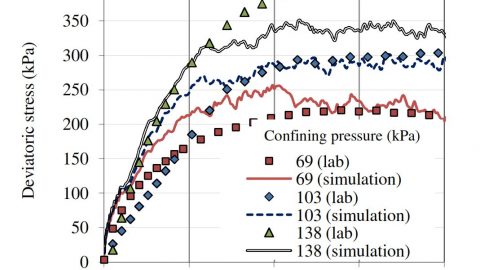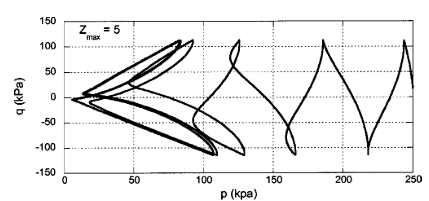Dear all
I’m studying hypo-plastic constitutive law from beginning concepts
I traced concepts successfully until i faced **rate independent topic**
i read this topic in the prof. Wolfgangs paper (hypo-plasticity for beginners)
he said that “Rate-independence means that the gradient of the curve (stiffness) does not depend on the strain rate, Thus the stress rate must be precisely twice as large for a double strain rate” and in the fallowing he said that “the constitutive law may not have terms like (strain rate^2) (strain rate square )”
as you know the hypo-plastic constitutive law is non-linear in strain rate
my question is that how hypo-plastic constitutive law can fulfill the non-linearity (in strain-rate) with no term like (strain rate^2)
Hypoplastic rate independent and non-linearity
Related Articles
-
Calibration Sand Hypoplasticity whit ExCalibre
 Francisco Mendez||Constitutive Modelling|3 |Views 4,139
Francisco Mendez||Constitutive Modelling|3 |Views 4,139
Dear all I have some laboratory test of Pescara sand and I’m trying to find the von Wolffersdorff parameters of this sand. So I have used ExCalibre with the data […] -
Hardening parameters (yield stress & absolute plastic strain)
 Amir Mohammad Yarahmadi||Constitutive Modelling|4 |Views 5,615
Amir Mohammad Yarahmadi||Constitutive Modelling|4 |Views 5,615
Hi to everyone I want to model a Sand with Cap plasticity or Drucker Prager failure criterion in ABAQUS, and I have the result of Triaxial test (I’ve attached the […] -
Calibration of the von Wolffersdorff model using Genetic Algorithms
 Francisco Mendez||Constitutive Modelling|3 |Views 4,114
Francisco Mendez||Constitutive Modelling|3 |Views 4,114
I am happy to announce that our pre-print paper, “Calibration of the von Wolffersdorff model using Genetic Algorithms”, is available on researchgate: https://www.researchgate.net/publication/342198062_Calibration_of_the_von_Wolffersdorff_model_using_Genetic_Algorithms. In this article, we propose a novel […] -
Cyclic/monotonic direct shear test (matlab driver)
 anis kheffache||Constitutive Modelling|2 |Views 5,478
anis kheffache||Constitutive Modelling|2 |Views 5,478
Hi everyone, i am trying to simulate DSS/cDSS test in drained/undrained conditions and I was wondering how the constraints matrices should be ? while it is easy to understand how […] -
Hypoplastic model for Granular soil
 Naveen Meena||Constitutive Modelling|5 |Views 4,956
Naveen Meena||Constitutive Modelling|5 |Views 4,956
Hello everyone, Could you please anyone tell me that how I can define the hypoplastic constitutive model for granular soil in ABAQUS 6.13. With Regards, Naveen. -
Clay Hypoplastic Model ABAQUS UMAT
 Hashmi Sohawon||Constitutive Modelling|3 |Views 4,439
Hashmi Sohawon||Constitutive Modelling|3 |Views 4,439
Hi, I wanted to ask if the variables/parameters defined in the online Hypoplastic model manual for PLAXIS (https://web.natur.cuni.cz/uhigug/masin/plaxumat/node6.html) are the same for the ABAQUS UMAT? -
Issues in getting the negative values of q (mean deviatoric stress) while simulating cyclic triaxial test in ABAQUS using SANISAND subroutine.
 MOHD SAQIB||Constitutive Modelling|5 |Views 4,314
MOHD SAQIB||Constitutive Modelling|5 |Views 4,314
Hello Everyone, I have been trying to simulate the cyclic triaxial test using the SANISAND04 subroutine. When I plotting the stress path (p-q plot), I am getting only the positive […] -
A question about the hypoplastic model in clay
 Wenbo Gu||Constitutive Modelling|7 |Views 4,337
Wenbo Gu||Constitutive Modelling|7 |Views 4,337
Hello, I am writting to ask how to get the elastic modulus or undrained strength of the soil in the simulation model by using hypoplastic model in clay? Is there […]
Search SoilModels Website
Recent posts
-
 Paper of Coulomb, C. A. (1773) 15.4.2024
Paper of Coulomb, C. A. (1773) 15.4.2024
-
 ABAQUS UMAT of hypoplastic clay model 6.4.2024
ABAQUS UMAT of hypoplastic clay model 6.4.2024
-
 Prague Geotechnical Days 2024 “Geotechnical monitoring” and 30th jubilee Prague Geotechnical Lecture by prof. Eduardo Alonso 5.4.2024
Prague Geotechnical Days 2024 “Geotechnical monitoring” and 30th jubilee Prague Geotechnical Lecture by prof. Eduardo Alonso 5.4.2024
-
 UMAT for Creep-SCLAY model. 1.3.2024
UMAT for Creep-SCLAY model. 1.3.2024
-
 Cyclic tests with Triax element test driver 14.2.2024
Cyclic tests with Triax element test driver 14.2.2024
-
 SUMMER SCHOOL ‘Numerical Modelling in Geotechnical Engineering’, Innsbruck – July 22nd-26th, 2024 1.2.2024
SUMMER SCHOOL ‘Numerical Modelling in Geotechnical Engineering’, Innsbruck – July 22nd-26th, 2024 1.2.2024
-
 COURSE IN SOIL MODELING – NTNU, Trondheim – October 14th to 18th, 2024 21.12.2023
COURSE IN SOIL MODELING – NTNU, Trondheim – October 14th to 18th, 2024 21.12.2023
-
 MSE walls design in Plaxis 11.12.2023
MSE walls design in Plaxis 11.12.2023
-
 sand liquefaction modelling in Anura3D 8.12.2023
sand liquefaction modelling in Anura3D 8.12.2023
-
 BCV bentonite experimental and modelling datasets 14.11.2023
BCV bentonite experimental and modelling datasets 14.11.2023
-
 Challenges in simulating geomechanical models using Mohr-Coulomb with Tension Cut-Off in Abaqus 20.10.2023
Challenges in simulating geomechanical models using Mohr-Coulomb with Tension Cut-Off in Abaqus 20.10.2023
-
 Analys soil liquefaction with Abaqus under blast load 19.10.2023
Analys soil liquefaction with Abaqus under blast load 19.10.2023
Recent Comments
- Gertraud Medicus on ABAQUS UMAT of hypoplastic clay model
- Chen Zhiming on Download Package of Charles University Implementation of High Cycle Accumulation Model
- Konstantinos Chatzis on Cyclic tests with Triax element test driver
- Abhay Pratap Singh on Cyclic tests with Triax element test driver
- Giovanni Ciardi on Cyclic tests with Triax element test driver
- Konstantinos Chatzis on Cyclic tests with Triax element test driver
- Ismail Khan on Cyclic tests with Triax element test driver
- Kanika Lamba on Cyclic tests with Triax element test driver
- Arie Koot on How to model the settlement in soil due to water drawdown.
- Konstantinos Chatzis on Cyclic tests with Triax element test driver
- Jose Duque on Cyclic tests with Triax element test driver
- MohamadReza Kamali on How to model the settlement in soil due to water drawdown.
- Leo Alibert on MSE walls design in Plaxis
- Ignacio Zuloaga on MSE walls design in Plaxis
- Giada Orlando on Problem with VUMAT interface
- Michael Spyridis on Problem with VUMAT interface
- Ahmad Moeineddin on Problem with VUMAT interface
- Nikolay Suyo Calla on Hardening soil Model UMAT





Dear Sobhan, hypo equation is defined as stressrate=L:strainrate * N||strainrate||. Here, ||strainrate|| is Euclidean norm of strainrate, that is sqrt(strainrate:strainrate). You see that the equation is non-linear in strainrate (if strainrate changes direction, stressrate changes direction differently as the term with N only quantifies strainrate size, not direction). You also see that actually, units of ||strainrate|| are still 1/time, as there is sqrt(strainrate^2) involved, thus it is consistent with comment by prof. Wolffersdorff which you cited. I suggest to have a loom into my book “Modelling of Soil Behaviour with Hypoplasticity”, where fundamentals of hypoplasticity are explained in (hopefully) clear way. Regards David
thank you so much!